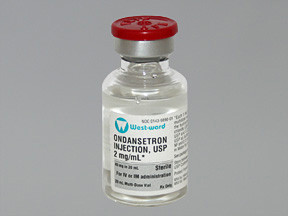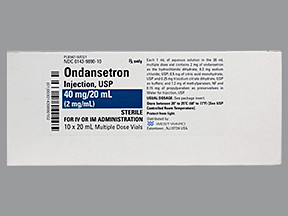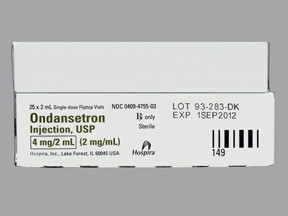ONDANSETRON - INJECTION
PHONETIC PRONUNCIATION: (on-DANS-eh-tron)
COMMON BRAND NAME(S): Zofran
GENERIC NAME(S): ondansetron HCl
Uses
USES: This medication is used alone or with other medications to prevent nausea and vomiting caused by cancer chemotherapy. It is also used to prevent and treat nausea and vomiting after surgery. It works by blocking one of the body's natural substances (serotonin) that causes vomiting.
How to use ONDANSETRON - INJECTION
HOW TO USE: To prevent nausea from chemotherapy, ondansetron is mixed in a solution and given by injection into a vein as directed by your doctor, usually over 15 minutes. This drug is usually started 30 minutes before your chemotherapy treatment begins. Do not give this medication any faster than recommended or take more than the recommended dose because this may increase the chance of serious side effects such as blurred vision or slowed/irregular heartbeat. The usual maximum single dose is 16 milligrams. Older adults are usually prescribed a lower dose to decrease the risk of side effects. Depending on the type of chemotherapy treatment you are receiving, a second and third dose may be given 4 and 8 hours after your first dose. You may also be switched to a medication you can take by mouth. Your doctor may direct you to continue this medication for 1 or 2 days after your chemotherapy treatment. If you are using this medication on a prescribed schedule, use it regularly to get the most benefit from it. To help you remember, use it at the same times each day. Use this medication exactly as directed. Do not use more medication or use it more often than prescribed. Ask your doctor or pharmacist if you have questions. If you are giving this medication to yourself at home, learn all preparation and usage instructions from your health care professional. When the vial is stored upright after first use, clumps may occasionally form on the top of the vial. Check the vial and the vial top carefully for particles. If particles are present, shake the vial to re-dissolve the particles. If any particles remain after the vial is shaken, do not use the liquid. Ondansetron injection should be clear and colorless. If you are using the premixed bags, after removing the bag from the outer wrapper, check for small leaks by squeezing the container firmly. Before using, check visually for leaks, particles, or discoloration. If these are present or the container is damaged, do not use the liquid. Learn how to store and discard medical supplies safely. To prevent or treat nausea after surgery, a single dose of ondansetron may be given undiluted into a muscle or vein (IV) shortly before the start of surgery, during surgery, or after surgery by a health care professional. Dosage is based on your weight, medical condition, age and response to treatment. Tell your doctor if your condition does not improve or if it worsens.
Side Effects
Precautions
Interactions
Overdose
Images
Reviews
Faq for ONDANSETRON - INJECTION
Ondansetron Injection is used to prevent nausea and vomiting caused by chemotherapy, radiation therapy, and surgery.
Ondansetron Injection works by blocking the actions of chemicals in the body that can trigger nausea and vomiting.
Ondansetron Injection is administered as an injection into a vein or as an injection into a muscle. It is usually given by a healthcare professional in a hospital or clinic setting.
Common side effects of Ondansetron Injection include headache, constipation, diarrhea, dizziness, and fatigue. If any side effects are severe or persistent, it is important to notify a healthcare professional.
Ondansetron Injection is generally considered safe to use during pregnancy, but it is important to consult with a healthcare professional before using any medication during pregnancy.
Yes, Ondansetron Injection can interact with certain medications, including some antidepressants and antipsychotics. It is important to inform a healthcare professional about all medications being taken to avoid potential interactions.
The effect of Ondansetron Injection can last for several hours, depending on the individual and the dose administered.
Yes, Ondansetron Injection can be used in children, but the dosage and administration guidelines may be different. It is important to follow the instructions provided by a healthcare professional.
No, Ondansetron Injection is a prescription medication and is not available over-the-counter.
Disclaimer
IMPORTANT: HOW TO USE THIS INFORMATION: This is a summary and does NOT have all possible information about this product. This information does not assure that this product is safe, effective, or appropriate for you. This information is not individual medical advice and does not substitute for the advice of your health care professional. Always ask your health care professional for complete information about this product and your specific health needs.







No Reviews Yet